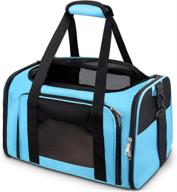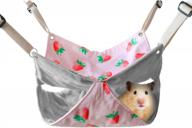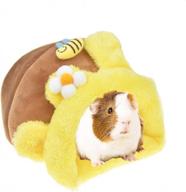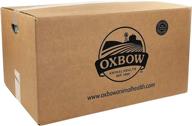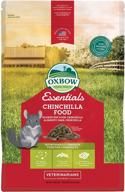How to choose the right hay for your small pet?
Choosing the right type of hay is important for your small pet's health. Here are some tips for selecting the best hay:
Consider your pet's species
Different small pets have different nutritional needs. For example:
- Rabbits - Timothy hay or orchard grass
- Guinea pigs - Timothy hay or alfalfa
- Chinchillas - Timothy hay
Look at hay quality
Higher quality hay is green, fragrant, and contains more nutrients. Avoid hay that is yellow, smelly or contains a lot of dust.
Select the right cut
The cut of the hay impacts how much your pet will enjoy it:
- Long-strand - harder for small pets to eat
- Chopped - easier for small pets to eat
Buy from a reputable source
Get hay from a supplier that produces it specifically for small animals. This ensures quality control.
Following these tips will help you pick the ideal hay to meet your small pet's nutritional needs and keep them healthy.
How to store hay to keep it fresh longer?
Properly storing hay is important to maintain its freshness and reduce waste. Here are some tips to keep hay fresher for longer:
Store hay in a dry location
Moisture causes hay to mold and rot. Store hay in a dry place like a shed, garage or barn.
Keep hay off the ground
Place hay bales on a pallet or platform to prevent moisture from being wicked up from the ground.
Use plastic tarps or bags
Covering stored hay with plastic tarps or storing in plastic bags creates a moisture barrier. Make sure to use UV-resistant plastic.
Allow air circulation
Storing hay tightly packed in an enclosed space traps humidity. Allow for air circulation around hay bales.
Check hay temperature
Insert a thermometer into bales periodically. Temperatures above 120°F indicate possible moisture or mold.
Divide stacks
Large hay stacks generate internal heat. Divide into smaller stacks of 2-3 bales to allow cooling.
Use hay within 6-12 months
Over time, even properly stored hay loses nutrients. Use within 6 months for maximum freshness and up to 12 months for acceptable quality.
Following proper storage methods helps retain nutrients and prevent mold growth. Storing hay correctly reduces waste and saves you money while keeping your pet's food fresh.
How to get your pet to eat more hay?
Hay should make up the majority of small pets' diets. Here are some tips to encourage your pet to eat more hay:
Offer hay in multiple locations
Place hay in your pet's sleeping area, hideouts, and other spots they frequent so it's always available.
Provide different hay types
- Alfalfa
- Oat
- Orchard grass
- Timothy
Rotate different hays to add variety and stimulate appetite.
Give fresh hay often
Replenish hay in your pet's habitat at least twice a day. Fresher hay is more appetizing.
Cut hay into smaller pieces
Chopped hay is easier for small pets to eat. Use scissors to cut hay into smaller bits.
Avoid overfeeding treats and pellets
Too many tasty treats and pellets can decrease your pet's hay intake. Stick to proper portions.
Make hay the only food at times
Restrict pellets and treats for periods of time so your pet fills up on hay.
Pair hay with favorite foods
Place hay near or inside treats and chew toys to encourage grazing.
With a few adjustments to how you offer hay, you can get your small pet to eat more of this essential food for their health.
Similar products
How to identify high quality orchard grass hay?
When choosing orchard grass hay for your small pet, look for these signs of quality:
Color
Good orchard grass hay is fresh green in color. Yellow or brown hay is old, dried out, and lower in nutrients.
Smell
High quality hay has a sweet, grassy fresh cut fragrance. Avoid hay that smells dusty, moldy, or fermented.
Leafiness
The hay should have lots of leafy material which is higher in protein and nutrients compared to stems.
Softness
The hay should feel soft and pliable, not coarse and tough. Softer hay is more palatable.
Seed heads
Orchard grass hay cut before seed heads form has better nutritional content.
Foreign material
Quality hay contains minimal stems, weeds, debris, dust, or insects.
Moisture content
Properly cured hay contains around 10-13% moisture. Too wet invites mold.
Cut style
Chopped hay is easier for small animals to eat than longer strands.
Always inspect orchard grass hay using sight, smell and touch. Only purchase green, fragrant bales that meets your pet's needs. Avoid any poor quality hay.
How to transition your pet to a new type of hay?
When changing your small pet to a new hay, follow these tips for a smooth transition:
Mix the hays
Slowly incorporate the new hay into the old hay over a period of 1-2 weeks. For example, do 25% new hay/75% old hay for a few days, then 50/50, etc.
Offer free choice
Give your pet both the old and new hays simultaneously so they can choose what to eat. This helps them adjust to the new texture and taste.
Monitor eating
Watch to see if your pet is eating the new hay. Look for decreased appetite or signs of digestive upset like soft stools.
Transition gradually
Take 2-4 weeks to fully change over to the new hay. A very slow transition prevents gastrointestinal issues.
Cut hay into small pieces
Chop up the new hay into bite-sized bits to make it more appealing and easier to eat.
Add fresh herbs
Mix in a few sprigs of tasty herbs like parsley, cilantro or dill to make the new hay more enticing.
Persist through pickiness
Your pet may ignore or refuse the new hay at first. Stick with the transition until they adapt to the taste and texture.
With patience and gradual introduction, you can successfully transition your small pet to a new type of hay. The key is going slowly to allow their digestive system to adjust.
How To Choose The Right Size Of Oxbow Animal Health Orchard Grass Hay For Your Small Animal?
Choosing the right size of Oxbow Animal Health Orchard Grass Hay for your small animal is important to ensure that they have enough hay to eat without wasting any. Here are some tips to help you choose the right size:
- Determine how much hay your small animal eats per day. This will depend on the type of animal you have and their size. For example, a rabbit may eat 1-2 cups of hay per day, while a guinea pig may eat 1/8 to 1/4 cup per day.
- Consider how many small animals you have. If you have multiple small animals, you will need to purchase more hay to ensure that everyone has enough to eat.
- Decide how often you want to purchase hay. If you have a large number of small animals or if your small animal eats a lot of hay, you may want to purchase a larger size to save money in the long run. However, if you have limited storage space or if your small animal eats a small amount of hay, a smaller size may be more appropriate.
- Check the expiration date on the hay. Make sure that the hay you purchase has a long enough shelf life to ensure that it will not go bad before your small animal has a chance to eat it.
- Consider the price. While larger sizes may be more cost-effective in the long run, they may not be feasible for everyone's budget. Make sure to choose a size that fits within your budget while still providing enough hay for your small animal.
By considering these factors, you can choose the right size of Oxbow Animal Health Orchard Grass Hay for your small animal.
What Are The Different Sizes Of Oxbow Animal Health Orchard Grass Hay Available?
Oxbow Animal Health Orchard Grass Hay is available in various sizes to suit the needs of different small animals and their owners. Here are the different sizes of Oxbow Animal Health Orchard Grass Hay available:
The smaller sizes are suitable for those who have only one or two small animals or those who have limited storage space. The larger sizes are more cost-effective for those who have multiple small animals or those who want to stock up on hay to save money in the long run. The availability of different sizes also allows small animal owners to choose the right amount of hay for their pets' needs and budget.
What Is The Price Range For The Different Sizes Of Oxbow Animal Health Orchard Grass Hay?
The price range for the different sizes of Oxbow Animal Health Orchard Grass Hay varies depending on the retailer and the size of the bag. Here are some examples of the price range for different sizes:
It's important to note that prices may vary depending on the retailer and any promotions or discounts that may be available. Additionally, some retailers may offer free shipping or other incentives that can affect the overall cost.





